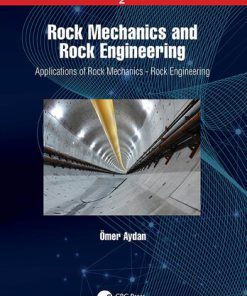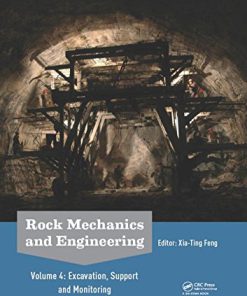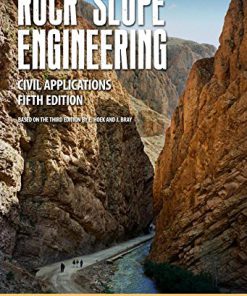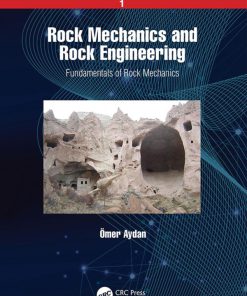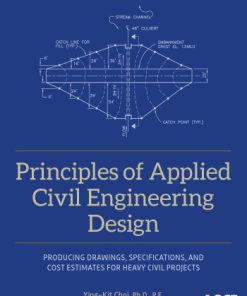Theory and Technology of Rock Excavation for Civil Engineering 1st edition by Dingxiang Zou 9811019890 9789811019890
$50.00 Original price was: $50.00.$25.00Current price is: $25.00.
Theory and Technology of Rock Excavation for Civil Engineering 1st edition by Dingxiang Zou – Ebook PDF Instant Download/DeliveryISBN: 9811019890, 9789811019890
Full download Theory and Technology of Rock Excavation for Civil Engineering 1st edition after payment.
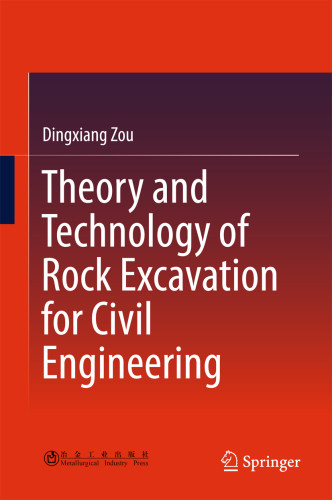
Product details:
ISBN-10 : 9811019890
ISBN-13 : 9789811019890
Author: Dingxiang Zou
This book summarizes the technical advances in recent decades and the various theories on rock excavation raised by scholars from different countries, including China and Russia. It not only focuses on rock blasting but also illustrates a number of non-blasting methods, such as mechanical excavation in detail. The book consists of 3 parts: Basic Knowledge, Surface Excavation and Underground Excavation. It presents a variety of technical methods and data from diverse sources in the book, making it a valuable theoretical and practical reference resource for engineers, researchers and postgraduates alike.
Theory and Technology of Rock Excavation for Civil Engineering 1st Table of contents:
1 Geology
1.1 Categories of Rock
1.1.1 Igneous Rocks
1.1.2 Sedimentary Rocks
1.1.3 Metamorphic Rocks
1.2 Properties of Rock
1.3 Geological Structures of Rock Mass
1.3.1 Folds
1.3.2 Faults
1.3.3 Discontinuities: Bedding Planes, Joints, and Fractures
1.3.4 The Compound Structures—Unconformities
1.3.5 Geometric Representation of Structural Elements
1.3.5.1 Definition of Geological Terms
1.3.5.2 Field Survey of a Geological Plane
1.3.5.3 Stereographic Projection
1.4 Properties of Rock Mass and Their Effects to Rock Excavation
1.4.1 Characterization of Discontinuities in a Rock Mass
1.4.2 Field Investigations on Rock Mass Properties
1.4.3 Groundwater
1.4.4 The Effects of Rock Mass Properties to the Excavation
1.4.4.1 Rock Strength and Joint Distribution to Blasting Fragmentation
1.4.4.2 Open Joints Cause Explosive Gas Venting
1.4.4.3 Wedge Failure on the Free Face Cause Flyrock
1.4.4.4 Fracture Zone in Rock Mass May Cause Bench Top Flyrock
1.4.4.5 Slope Failure by Discontinuities
1.4.4.6 Rock Failure During Tunnel Excavation Caused by Discontinuities
1.4.4.7 Groundwater Affects Underground Excavation
1.5 Classification of Rock Sturdiness
1.5.1 Protodyakonov’s Rock Classification
1.5.2 “Three in One” Comprehensive Classification of Rock Mass
1.5.3 China’s “Standard for Engineering Classification of Rock Masses” GB50218-2014
1.5.3.1 Factors of Classification for Basic Quality of Rock Masses
1.5.3.2 The Qualitative Division of the Hardness Degrees of Rock
1.5.3.3 The Qualitative Division of the Intactness Degree of Rock Masses
1.5.3.4 The Quantitative Indexes Determination and Division for Rock Masses
1.5.3.5 Classification of the Basic Quality of Rock Masses
References
2 Rock Drilling
2.1 Mechanism of Rock Breakage by Drilling and Drillability of Rock
2.1.1 Mechanism of Rock Breakage During Drilling
2.1.2 Drillability of Rock and Its Classification
2.1.2.1 NTNU/SINTEF Method and Classification of Rock Drillability
2.1.2.2 Rock Drillability Classification Using the Method of Impact Penetrate
2.2 Classification of Drilling Machines
2.2.1 Classification on Drilling Manner
2.3 Classification on Drilling Methods
2.4 Rotary-Percussive Drilling
2.4.1 Top Hammer Drilling
2.4.1.1 Pneumatic Rock Drills
2.4.1.2 Hydraulic Rock Drill
2.4.1.3 Hydraulic Drilling Rigs
2.4.2 Down-the-Hole (DTH) Drilling
2.5 Rotary Drilling
2.5.1 Rotary Drilling with Rolling Tricone Bits
2.5.2 Rotary Drilling with Drag Bits
2.6 Rotary-Percussive Drilling Accessories
2.6.1 Integral Drill Steels
2.6.2 Type of Threads
2.6.3 Shank Adapters
2.6.4 Drill Rods
2.6.4.1 Drifter Rods
2.6.4.2 Extension Rods
2.6.4.3 Drill Tubes
2.6.5 Couplings
2.6.6 Drill Bits
2.6.6.1 Insert Bits
2.6.6.2 Button Bits
2.6.6.3 Special Bits
2.6.6.4 Down-the-Hole Hammer Bits
2.6.6.5 Bit Maintenance
2.6.7 The Service Lifetime of Drilling Accessories
2.7 Selection of Rock Drill and Accessories
2.7.1 Fields of Application for Different Drilling Methods
2.7.2 Principles of Selection of Drilling Equipment for Surface Excavation
2.7.3 Selection of Drilling Equipment for Underground Excavation
2.7.4 Selection of Drilling Accessories
2.7.4.1 The Features of Button Bit Design
2.7.4.2 Selection of Drilling Bits
2.7.4.3 Drilling Rod Selection
Top hammer Rods Selection for Surface Drilling
Rods Selection for Underground Jumbos
References
3 Explosives
3.1 History of Explosives Development
3.2 Characters of Explosion of Explosives
3.3 Types of Chemical Decomposition of Explosives and the Detonation Process
3.3.1 Types of Chemical Decomposition of Explosives
3.3.2 Detonation Process of an Explosive
3.4 Oxygen Balance of Explosives
3.5 Thermochemistry of Explosives
3.5.1 Detonation Heat of Explosives
3.5.1.1 Calculation of Detonation Heat of Explosives
3.5.1.2 Calorimetric Determination of Detonation Heat of Explosives
3.5.2 Detonation Temperature of Explosives
3.5.3 Detonation Volume of Explosives
3.5.4 Detonation Pressure and Velocity of Detonation of Explosives
3.6 Classification of Explosives
3.6.1 Classification by Composition
3.6.2 Classification by Sensitivity
3.6.3 Classification by Detonation Velocity
3.6.4 Classification by Purpose (Application)
3.6.5 Classification by IMDG Code [17]3.7 Properties of Explosives
3.7.1 Density
3.7.1.1 Detonation Velocity
3.7.2 Strength and Energy
3.7.2.1 Trauzl Test
3.7.2.2 Brisance—Hess Test
3.7.2.3 Ballistic Mortar Test
3.7.2.4 Underwater Test
3.7.2.5 Blasting Crater Test
3.7.3 Sympathetic Detonation
3.7.4 Sensitivity
3.7.4.1 Detonator or Cap Sensitivity
3.7.4.2 Sensitivity to Heat, Impact, and Friction
3.7.5 Water Resistance
3.7.6 Fumes and Fume Classification
3.7.7 Desensitization
3.7.8 Stability and Shelf Life for Storage
3.8 Commercial Explosives (Industrial Explosives)
3.8.1 Nitroglycerin (NG)-Based Explosives
3.8.2 AN-TNT-Based Explosives—Ammonite
3.8.2.1 Main Ingredients
3.8.3 Water-Based Explosives
3.8.3.1 Water Gels/Slurries
3.8.3.2 Emulsion Explosives
3.8.4 Bulk Blasting Agent
3.8.4.1 Ammonium Nitrate/Fuel Oil Mixtures (ANFO)
3.8.4.2 Bulk Emulsion and Heavy ANFO
References
4 Initiation System
4.1 Detonators
4.1.1 Brief History on Detonators
4.1.2 Plain Detonators and Safety Fuses
4.1.3 Electric Detonators
4.1.3.1 Structure of Electric Detonators
4.1.3.2 Electrical Parameters of Electric Detonators
4.1.3.3 Delay Detonators
4.1.3.4 Timing Accuracy
4.1.4 Electromagnetic Detonators
4.1.5 Shock Tube Detonators (Nonel System)
4.1.5.1 Composition of Shock Tube Detonators
4.1.5.2 Types of Shock Tube Detonators
4.1.5.3 Initiation Methods for Shock Tube Detonator System
4.1.6 Electronic (Digital) Detonators
4.2 Detonating Cord
4.3 Cast Boosters
References
5 Mechanisms of Rock Breakage by Blasting
5.1 Shock Wave and Stress Wave in Rock Generated by Explosion
5.1.1 Shock Wave and Stress Wave
5.1.2 Types of Stress Wave
5.1.3 Reflection of Stress Wave from a Free Face
5.2 Mechanism of Rock Breakage by Blasting
5.2.1 Crushed Zone Produced by Shock Waves
5.2.2 Radial Cracking Zone Produced by Stress Waves
5.2.3 Reflection of Stress Waves from Free Face
5.2.4 Role of the Explosion Gases
5.3 Explosive’s Energy Distribution During Rock Blasting and Livingston’s Blasting Crater Theory
5.3.1 Explosive’s Energy Distribution During Rock Blasting
5.3.2 Livingston’s Crater Blasting Theory
5.3.2.1 Parameters of Crater Blasting
5.3.2.2 Livingston’s Crater Blasting Theory [11, 12]5.4 Rock Classification by Blastability
5.4.1 Rock Blastability and Its Effective Factors
5.4.1.1 The Effect of the Structures (Mineral Composition), Cohesion, and Fissures of Rock on Rock B
5.4.1.2 The Effect of the Density, Porosity, and Broken-Dilatability of Rock on Rock Blastability
5.4.1.3 The Influence of Elastic, Plastic, Brittle, and Strength of Rock on Rock Blastability
5.4.1.4 The Influence of Blasting Parameters and Process on Rock Blastability
5.4.1.5 The Influence of Explosive Performance on Rock Blastability
5.4.1.6 The Influence of the Matching of Wave Impedance of Both Explosive and Rock mass on Rock Blas
5.4.2 Criterion of Rock Classification by Blastability
5.4.2.1 Criterion of Mechanical Strength of Rock
5.4.2.2 Criterion of Powder Factor of Explosives
5.4.2.3 Criterion of Parameters of Engineering Geology
5.4.2.4 Criterion of Speed of Elastic Wave in Rock mass
5.4.2.5 Criterion of Energy
5.4.2.6 Criterion of Critical Fracture Velocity of Rock
5.4.3 Rock Classification by Blastability
5.4.3.1 Rock Blastability Classification by Protodyakonov (M.M. Пpoтoдьякoнoв) (1926) and Su
5.4.3.2 Rock Blastability Classification by Hanukaev (1969)
5.4.3.3 Rock Blastability with Livingstone’s Strain-Energy Factor (1956)
5.4.3.4 Rock Blastability Index Developed by Lilly (1986) and Ghose (1988) [8]5.4.3.5 Rock Blastability Index Developed by Rakishev [9]5.4.3.6 Rock Classification by Blastability Developed by Northeastern University, China (1985) [10]References
6 Blasting Assessment Report
6.1 Desk Study
6.1.1 Gathering Information from Relevant Authorities
6.1.2 Identification of the Area Which Will Be Affected by the Blasting Works
6.1.3 Contact and Collect Necessary Information from All Units Within the Affected Area by the Excav
6.1.4 Collect Necessary Information About Existing Geotechnical Features, Meteorological, and Hydrog
6.2 Field Investigation and Condition Survey
6.2.1 Investigation, Including Photography and Surveying, of the Current Condition of All Facilities
6.2.2 Field Investigation of All Geotechnical and Geological Features Within the Zone of Influence b
6.2.3 Records of Existing Defects
6.3 Analysis of the Potential Influence of Blasting Works to the Environment
6.3.1 Environment Impact Assessment (EIA) for the Transport and Storage of Explosives
6.3.2 Potential Risk of Blasting Flyrock
6.3.3 Influence of Blasting Vibration
6.3.3.1 Influence of Blasting Vibration and Its Prediction
6.3.3.2 Analysis of Stability for Slopes and Other Geotechnical Works and Geological Features
6.3.4 Influence of the Air Overpressure Produced by Blasting
6.3.5 Arrangement of the Monitoring Points for All Sensitive Receivers
6.4 Proposals for Elimination or Controlling the Adverse Influences
6.4.1 Protective Measures for Prevent Blasting Flyrock
6.4.2 Limitation of Blasting Vibration for All Protective Objects and Its Controls
6.4.2.1 Limits of Blasting Vibration Usually Used in Hong Kong (Reproduced From ref. [5]) by Permiss
6.4.2.2 Safety Limitation of Blasting Vibration in P. R. China [6]6.4.2.3 Blasting Vibration Regulation in USA
6.4.2.4 Transient Vibration Guide Values for Cosmetic Damage in UK
6.4.2.5 Blasting Vibration Criteria Recommended in Australia
6.4.2.6 Blasting Vibration Criteria Recommended in Scandinavian Countries (Reproduced from ref. [11]6.4.2.7 Blasting Vibration Criteria Recommended in Germany (Reproduce from Ref. [11] by Permission o
6.4.3 Limitation of Air Overpressure
6.4.3.1 Limits and Guidelines Specified in USA [7]6.4.3.2 Limits and Guidelines Specified in Safety Regulations for Blasting of P.R. China, GB 6722-20
6.4.3.3 Limits and Guidelines Specified in Australia and New Zealand
6.4.3.4 Limits and Guidelines Specified in Canada
6.4.3.5 Limits and Guidelines Specified in Hong Kong
6.4.4 Equipment for Monitoring
6.4.5 Levels of Alert, Action, and Alarm of Blasting Vibration and AOP and Corresponding Requirement
6.5 Methodology of the Excavation by Blasting
6.5.1 Arrangement of Excavation Process
6.5.2 Working Scale, Excavation Method, and Main Equipment
6.5.3 Explosives to Be Used in the Project and the Outline of Blasting Design
6.5.4 Security Measures, Scope of Safe Evacuation, and Evacuation Program
6.5.5 Assessment of the Feasibility of an On-Site Explosive Magazine, and Its Arrangement and Securi
Annex: Contents of a Blasting Assessment
References
Surface Excavation
7 Non-blasting Excavation
7.1 Manual Splitting and Hydraulic Rock Breaker
7.1.1 Manual Splitting
7.1.2 Hydraulic Hammer Breaker
7.2 Hydraulic Rock Splitters
7.2.1 Wedge-Type Hydraulic Splitters
7.2.2 Piston-Type Hydraulic Rock Splitter
7.3 Non-explosive Cracking Agent
7.4 Other Non-explosive Excavation Methods
7.4.1 Controlled Foam Injection [2]7.4.2 Gas Pressure Rock-Breaking Products
7.4.2.1 Cardox: CO2 Non-detonating Expansion System [3]7.4.2.2 GasBlaster™: A Gas Pressure Blasting Product [4]7.4.3 Pulse Plasma Rock Splitting Technology (PPRST) [5]References
8 Bench Blasting
8.1 Geometrical Parameters of Bench Blasting
8.1.1 Blasthole Inclination, β
8.1.2 Blasthole Diameter, D
8.1.3 Height of Bench, H
8.1.4 Burden, W
8.1.5 Spacing, S
8.1.6 Subdrilling, H
8.1.7 Stemming, L2
8.1.8 Blasthole Pattern
8.2 Specific Charge (Powder Factor) and Explosive Charging Calculation
8.2.1 Specific Charge (Powder Factor)
8.2.2 Calculation of Explosive Charging
8.2.2.1 Charge Weight for a Blasthole
8.2.2.2 Linear Charge Concentration
8.3 Charge Configuration
8.3.1 Continuous Charge
8.3.2 Continuous Decking Charges (Fig. 8.8b)
8.3.3 Isolated Deck Charges (Fig. 8.8c)
8.4 Firing Method and Firing Sequence
8.4.1 Electric Detonator Initiation System
8.4.1.1 Formulae for Electric Firing Circuits
8.4.1.2 Recommended Wire Splices
8.4.1.3 Firing Sequence Design
8.4.2 Shock Tube Detonator Initiation System
8.4.2.1 Millisecond Delay System
8.4.2.2 Unidet System
8.4.3 Electronic Detonator Firing Sequence Design
8.5 Delay Timing
References
9 Trench Blasting
9.1 Blasthole Pattern and Firing Sequence
9.1.1 Blasthole Diameter
9.1.2 Drilling Pattern
9.1.3 Firing Sequence
9.2 Explosive Charging
9.3 Blasting Safety in Trench Excavation
References
10 Contour Blasting Technique for Surface Excavation
10.1 Types of Contour Blasting
10.2 Presplitting and Smooth Blasting
10.2.1 The Characters of Presplitting and Smooth Blasting Holes
10.2.2 The Mechanism of Presplitting and Smooth Blasting
10.3 Parameters of Presplitting and Smooth Blasting
10.3.1 Theoretical Approaches
10.3.2 Empirical Approaches
10.4 Blast Design, Charging, and Initiation for Presplitting and Smooth Blasting
10.4.1 Blast Design of Presplitting and Smooth Blasting
10.4.2 Explosive Charging for Presplitting and Smooth Blasting Holes
10.4.3 Stemming and Initiation of Contour Blasting Holes
10.4.3.1 Stemming
10.4.3.2 Initiation of the Contour Blast
10.5 Cushion Blasting and Line Drilling
10.5.1 Cushion Blasting
10.5.2 Line Drilling
References
11 Blasting Safety for Surface Blasting
11.1 General Roles of Blasting Operation
11.2 Flyrock and Its Control
11.2.1 Flyrock and Its Cause of Formation
11.2.2 Calculation of Flyrock Distance
11.2.3 Precaution and Protective Measured for Flyrock
11.2.3.1 Measures for Reducing the Risk of Flyrock
11.2.3.2 Evacuation Distance and Evacuation Procedure
11.2.3.3 Protective Measures for the Prevention of Flyrock
11.3 Ground Vibration and Its Control
11.3.1 Ground Vibration Produced by Rock Blasting
11.3.1.1 Propagation Velocity and Particle Velocity
11.3.1.2 Type of Seismic Waves
11.3.1.3 Parameters of Seismic Waves
11.3.2 Factors which Affect the Magnitude of Ground Vibration
11.3.2.1 Site Geology
11.3.2.2 Distance from the Blasting
11.3.2.3 Type, Amount, and Coupling of Explosives
11.3.2.4 Geometric Parameters of Blasting Design
11.3.2.5 Detonator Timing Scatter
11.3.3 Controlling Ground Vibration During Blasting
11.3.4 Prediction and Restriction Criteria of Ground Vibration by Rock Blasting
11.3.4.1 Prediction of Ground Vibration Induced by Blasting
11.3.4.2 Restriction Criteria of Ground Vibration by Rock Blasting
11.3.5 Instrumentation for Monitoring Blasting Vibration
11.4 Air Overpressure Produced by Surface Blasting and Its Control
11.4.1 Air Overpressure Produced by Surface Blasting
11.4.2 Factors which Affect the Air Overpressure [14]11.4.3 Estimation of Air Overpressure
11.4.4 Criteria for Limiting Air Overpressure in Surface Blasting
11.4.5 Measures for Reducing Air Overpressure Produced by Surface Blasting
References
12 Blasting Models and Computer-Aided Design for Bench Blasting
12.1 Introduction
12.1.1 Blasting Models
12.1.2 Computer-Aided Blasting Design
12.1.3 Size Distribution of Rock Fragments in Blasting
12.1.3.1 Description of the Degree of Rock Fragmentation in Blasting
12.1.3.2 Distribution Functions of Rock Fragments
12.2 Some Typical Blasting Models
12.2.1 Harries’ Mathematical Model (Reproduced from Ref. [9, 17] with the Permission from the Aust
12.2.2 Favreau’s Model and BLASPA Simulation Program (Reproduced from Ref. [20] by Permission of L
12.2.3 Kuz–Ram Model (Reproduced from Ref. [21] with the Permission from Luleå University of Tech
12.2.4 BMMC Mathematical Model (Reproduced from Ref. [3] with the Permission of Copyright © 1987 SE
12.2.5 Blasting Models for Jointed Rock Mass
12.2.5.1 Gama Model (Reproduced from Ref. [26] with the Permission from Luleå University of Technol
12.2.5.2 Bezmatlih Model [27]12.2.6 SABREX Model (Reproduce from Ref. [28] with Permission from the Canada Institution of Mining,
12.3 Some Typical Program of Computer-Aided Design
12.3.1 Blast Maker [33]12.3.2 EXPERTIR [34]12.3.3 Blast-Code (Reproduced from Ref. [8, 29] by Permission of the Author, Prof. Qu S. J. et al.)
12.3.3.1 Database for the Blast-Code Model
12.3.3.2 Module FRAG+ for Blast Design
12.3.3.3 Module DISP+ for the Prediction of Muck Pile Profile and Fragmentation
12.3.4 IESBBD (Reproduced from Ref. [31] with the Permission from Copyright © 2003nEuropean Federat
12.3.4.1 The Composition and Structure of IESBBD
12.3.4.2 Design Flowchart of IESBBD
References
Underground Excavation
13 Introduction
13.1 Type and Features of Underground Excavation
13.2 Relationship Between Underground Excavation and Environment
13.2.1 Effects of Underground Excavation to the Environment
13.2.2 Environment Restrictions to the Underground Excavation
13.3 Methods of Underground Excavation in Rock
References
14 Mechanical Underground Excavation in Rock
14.1 Drilling and Breaking Method
14.2 Roadheader Excavation
14.3 Raise Boring
14.3.1 Methods of Raise Boring
14.3.2 Main Uses of Raise Boring in Civil Construction [3]14.3.3 Main Benefits of Raise Boring [3]14.4 Tunnel Boring Machine (TBM)
14.4.1 Introduction [9–11, 15]14.4.2 Classification of TBM
14.4.2.1 Gripper TBM
14.4.2.2 Shield TBM
14.4.2.3 Closed Systems
14.4.3 Mechanism of Rock Breakage by Cutting Tools
14.4.4 Operation Systems of TBM
14.4.4.1 Boring System
14.4.4.2 Thrust and Gripping System
14.4.4.3 Muck Removal System
14.4.4.4 Support System
14.4.4.5 Operation System
14.4.4.6 Other Backup Systems
14.4.5 TBM Type Selection
14.5 Mechanical Excavation for Shaft Sinking
14.5.1 Roadheader Excavation: Vertical Shaft Machine (VSM) [14]14.5.2 Shaft Boring Machine (SBM)
14.5.2.1 Reproduce from Refs. [13] and [14] by permission of Herrenknecht AG
14.6 Bored Piles in Rock
14.6.1 Small- to Medium-Sized Bored Pile (Generally Refers to Piles Ranging in Size from 300 to 900
14.6.2 Large-Diameter Concrete Bored Pile [16]References
15 Other Underground Excavation Methods
15.1 Cut-and-Cover Method
15.1.1 Construction Methods of Cut-and-Cover
15.1.2 Support Methods for the Sidewalls of the Excavation
15.2 Jacked Box Tunneling and Pipe Jacking
15.2.1 Jacked Box Tunneling
15.2.2 Pipe Jacking
References
16 Introduction to Underground Excavation by Drilling and Blasting
16.1 Introduction
16.1.1 Working Cycle of Excavation by D & B
16.1.2 Working Condition
16.1.3 Drilling Equipment, Explosives, and Blasting Design
16.2 Excavation Methods for Tunnels and Caverns
16.2.1 Full-Face Excavation
16.2.2 Partial Face Excavation
16.2.2.1 Top Heading and Benching
16.2.2.2 Pilot Heading
16.2.2.3 Sidewall Drift
16.3 Excavation Methods for Shaft
16.3.1 Shaft Sinking
16.3.2 Raise Driving
16.3.2.1 The Two-Compartment Raise Method
16.3.2.2 Jora Lift Method (Hanging Basket Method)
16.3.2.3 Alimak Raise Climber Method
16.3.2.4 Long Hole Blasting Method
16.4 Explosive Charging
16.4.1 Manual Charging
16.4.2 Pneumatic Charging
16.4.2.1 Pumpable Emulsion Charging
References
17 Contour Blasting for Underground Excavation
17.1 The Characters of Contour Blasting for Underground Excavation
17.2 Charge Calculation for Smooth Blasting
17.3 Blasthole Charging for Smooth Blasting
References
18 Blasting Design for Underground Excavation
18.1 Blasting Design for Tunnel (Cavern)
18.1.1 Hole Layout and Firing Sequence
18.1.2 Types of Cut-Hole Pattern
18.1.2.1 Angled Hole Cuts
18.1.2.2 Parallel-Hole Cut
Burn Cuts
Parallel-Hole Cuts with Large Empty Hole(S): Cylinder Cuts
18.1.3 Some Important Issues on Cut Holes and Tunnel Blasting
18.1.3.1 The Concept of Cut “Freezing”
18.1.3.2 Stemming
18.1.3.3 Lookout Angle
18.1.4 Parallel-Hole Cut Design: Cylinder Cuts
18.1.4.1 Large Hole Diameter and Number
18.1.4.2 Spacing of Cut Holes
18.1.4.3 Four-Section Design for Parallel-Hole Cut
18.1.5 Blasthole Pattern for Stoping
18.1.6 Lifter Holes
18.1.7 Contour Holes
18.1.8 Lineal Charge Concentration of Blasthole
18.1.8.1 Cut Holes
18.1.8.2 Stoping Holes
18.1.8.3 Lifter Holes
18.1.8.4 Contour Holes
18.1.9 General Information for Tunnel Blasting Design
18.1.9.1 Simplified Calculation for Designing Drilling and Blasting Pattern in Tunnels
18.1.9.2 Relationship between Drillhole Number and Tunnel Cross-Sectional Area
18.1.9.3 Relationship between Explosives Consumption and Tunnel Cross-Sectional Area
18.1.9.4 Specific Drilling
18.2 Blasting Design for Shaft: Full Face Sinking
18.2.1 Types of Cut-Hole Pattern
18.2.1.1 “V”-Cut
18.2.1.2 Cone Cut
18.2.1.3 Parallel-Hole Cut with Relief Hole(S)
18.2.2 Blasting Parameters for Shaft Blasting
18.3 Firing Sequence Design for Underground Blasting
18.3.1 Principle of Firing Sequence Design
18.3.2 Small Tunnel
18.3.3 Large Tunnel
18.3.3.1 Bunch Connector Method
18.3.3.2 Detonating Cord Ring Connection Method
18.3.4 Tunnel Blasting with Electronic Detonators
18.3.4.1 Example 1: SmartShot Electronic Detonators’ Tunnel Blasting Design
18.3.4.2 Double-Deck Tunnel Blasting Using Electronic Detonators [9]18.4 Computer-Aided Tunnel Design and Management
18.4.1 Sandvik ISURE® Software: Tunnel Management Software (Reproduced from Refs. [10, 11] with the
18.4.2 Atlas Copco: Underground Manager MWD (Reproduced from Refs. [12, 13] with the permission from
References
19 Loading and Transportation for Underground Excavation
19.1 Loading and Haulage in Tunnel
19.1.1 Wheel Loader and Dump Truck
19.1.2 Continuous Mucking Machine and Shuttle Car/Belt Conveyor
19.1.3 Railway Transportation
19.2 Loading and Hoisting in Shaft Excavation
19.2.1 Manual Shaft Sinking
19.2.2 Mechanizing Shaft Sinking
19.2.2.1 Simple Mucking and Hoisting Equipment
19.2.2.2 Specialized Mucking and Hoisting System
References
20 Ventilation for Underground Excavation
20.1 Requirement of Ventilation for Underground Excavation
20.1.1 Requirement of Air Quality
20.1.2 Fresh Air Supply Quantities
20.2 Ventilation Equipment
20.2.1 Ventilation Machine: Fans
20.2.2 Requirements to Ventilation Equipment
20.2.3 Type of Fans for Underground Ventilation System
20.3 Design of Ventilation System
20.3.1 Calculation of Discharge Volume of Ventilation (Refer to [4])
20.3.2 Calculation of Ventilation Pressure (Refer to [2])
20.3.3 Design of Fan and Ventilation Duct [4]20.3.4 Choose of Van
20.3.5 Ventilation Duct
20.4 Ventilation Types for Underground Excavation
20.4.1 Supply Ventilation (Press or Forcing Ventilation) (Fig. 20.5a) (Photo 20.4)
20.4.2 Extraction (Exhaust)-Only Ventilation (Fig. 20.5b)
20.4.3 Compound Type of Ventilation (Overlap System) (Fig. 20.5c)
20.5 Ventilation Optimization
References
21 Ground Reinforcement and Support
21.1 Effects of the Stability of Rock Mass to Underground Excavation
21.1.1 Concept of Ground Pressure and Stress Pattern Around Underground Excavation
21.1.2 Effects of Ground Conditions on Underground Excavation
21.1.3 Classification of Stability of Rock Mass for Excavation
21.1.3.1 Terzaghi’s Rock Mass Classification
21.1.3.2 Rock Quality Designation Index (RQD)
21.1.3.3 RMR System: Geomechanics Classification
21.1.3.4 Q-System, NGI Tunneling Quality Index
21.2 Ground Prereinforcement for Excavation
21.2.1 Ground Freezing
21.2.1.1 Ground Freezing Method
21.2.1.2 Principles of Freezing
21.2.1.3 Application of Freezing for Underground Excavation
21.2.2 Grouting
21.2.2.1 Grouting in Rock [4]21.2.2.2 Categories of Grouting
21.2.2.3 Grouting Equipment
21.3 Initial Support of Newly Excavated Space
21.3.1 Rock Dowels, Rock Bolts, and Rock Anchors
21.3.2 Types of Rock Bolts
21.3.2.1 Mechanically Anchored Bolts
21.3.2.2 Friction-Type Bolts
21.3.2.3 Grouted Bolts
21.3.3 Application Guideline and Equipment for Bolt Installation
21.3.3.1 Guideline of Rock Bolting
21.3.3.2 Equipment for Bolt Installation
21.3.4 Installation of Wire Mesh on Rock Face
21.3.5 Shotcrete
21.3.6 Steel Arch Ribs and Steel Lattice Arch Girders
21.3.7 Spiling (Forepoling) and Pipe Roofing
21.3.8 Portal Excavation and Temporary Support
21.4 Permanent Support for Underground Excavation
21.4.1 Selection of Permanent Support
21.4.2 Types of Permanent Support [13]21.4.2.1 Unlined Rock Tunnel
21.4.2.2 Sprayed Concrete (Shotcrete)
21.4.2.3 Ribbed System
21.4.2.4 Segmental Lining
21.4.2.5 In Situ Concrete Lining
21.5 New Austrian Tunneling Method (NATM)
References
22 Monitoring and Instrumentation for Underground Excavation
22.1 Introduction [5–7]22.2 Settlement Monitoring
22.2.1 Ground Settlement Monitoring
22.2.2 Utility Settlement and Building Settlement Monitoring
22.3 Displacement and Deformation Monitoring
22.3.1 Inclinometer Monitoring
22.3.2 Magnetic Extensometer and Monitoring
22.3.3 Tiltmeter
22.3.4 Crack Monitoring: Telltales
22.3.5 Convergence Array Monitoring
22.3.6 Time-Domain Reflectometer Probe: Slope Movement Detector
22.4 Groundwater Monitoring
22.4.1 Standpipe and Piezometer [3]22.4.2 Vibrating Wire Piezometer [4]22.4.3 Pore Water Pressure Gauge
22.5 Ground Vibration and AOP Monitoring
22.6 Instrumentation Management
22.6.1 Instrumentation Selection
22.6.2 Frequency of Monitoring Readings
22.6.3 Warning Mechanism: 3A Levels
References
23 Health and Safety, and Risk Management in Underground Excavation
23.1 Introduction
23.2 General Requirements for Underground Excavation
23.2.1 Employee Identification System
23.2.2 Illumination
23.2.3 Communication
23.2.4 Signals
23.3 Major Hazards and Risks and the Elimination Measures
23.3.1 Ground Risk
23.3.2 Ground Vibration Produced by Blasting
23.3.3 Tunnel Boring Machine (TBM)
23.3.4 Tunnel Transport
23.3.5 Shaft Under Construction
23.3.6 Tunnel Atmosphere and Air Quality Control
23.3.7 Fire and Rescue System
23.3.8 Explosives and Blasting Works
23.3.8.1 General Requirement for Explosives and Blasting Works
23.3.8.2 Blasting Door
23.3.8.3 Reduce Blasting Impact and Noise
23.4 Explosives Stored in Site Magazine and Site Transportation
23.4.1 Site Explosives Magazine
23.4.1.1 Types of Explosive Magazines
23.4.1.2 Safety Requirements for Site Explosives Magazine
23.4.1.3 Construction of Outdoor Site Explosive Magazine
23.4.1.4 Management of Site Explosives Magazine
23.4.2 Explosives Transport (Relevant Contents from Ref. [18] by Permission of Mines Division, GEO,
23.4.3 Fire Extinguisher for Site Magazine and Explosives Trucks and Its Use
23.4.4 Emergency Plan
People also search for Theory and Technology of Rock Excavation for Civil Engineering 1st:
rock excavation techniques
rock excavation methods
excavating through rock
rock engineering theory
theory of rock
Tags: Theory, Technology, Rock Excavation, Civil Engineering, Dingxiang Zou
You may also like…
Engineering - Civil & Structural Engineering
Engineering - Civil & Structural Engineering




